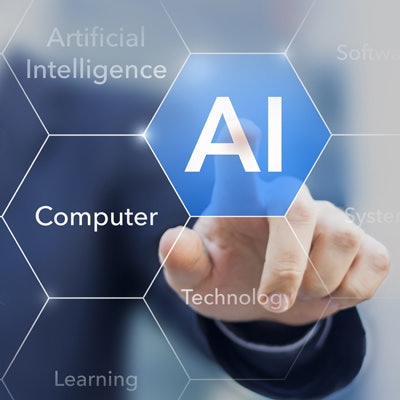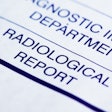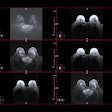
The promise of artificial intelligence (AI) for medical image analysis may draw most of the attention, but AI has the potential to enhance the entire medical imaging process and enable "intelligent" imaging systems, according to market research firm Frost & Sullivan.
Cognitive computing techniques can be applied to enhance the entire medical imaging chain, leading to the development of "smart" medical imaging processes, said Nadim Daher, industry principal for medical imaging and informatics at the firm.
AI could also be embedded within imaging modalities, ushering in a new era of medical imaging instrumentation, he said during an August 9 webinar.
"Image analysis is the low-hanging fruit for AI, but there's a lot more coming," he said.
A dynamic market
The initial focus for applying artificial intelligence in medical imaging applications was on utilizing the technology on-premises -- applying local niche algorithms to images in traditional radiology environments. Over the past two to three years, however, the market has been moving toward delivering AI technology to users via the cloud -- making AI more widely available and enabling algorithms to continuously learn from a higher usage volume, Daher said.
Perhaps a more exciting trend, though, is a move toward applying AI algorithms at the "edge" -- i.e., performed at the imaging modalities themselves rather than a PACS or postprocessing workstation, according to Daher. The first steps are being made toward embedding deep-learning AI technology into scanners, applying algorithms to raw image data.
The medical imaging AI marketplace today is characterized by a dynamic and diversified competitive landscape, including major cloud computing vendors with partner-based imaging AI initiatives, computing acceleration vendors, cloud marketplace vendors, health IT vendors with a cloud partner ecosystem, core medical imaging and informatics vendors, major IT vendors, and more than 90 independent software vendors, according to Daher. The total number of medical imaging analysis AI start-ups has also grown from two in 2009 to 83 in 2017.
Money has also poured into this field. More than $1 billion -- led by $466.5 million invested in cardiovascular software developer HeartFlow -- has been raised in fewer than five years in the medical imaging AI market, Daher said. That total rises to as much as $6 billion if you include merger and acquisition activity and research and development from established market players, he added.
Image analysis
The use of AI for automating, accelerating, or augmenting image analysis remains the primary area of market activity for medical imaging AI. Sid Shah, an industry analyst for visionary healthcare at Frost & Sullivan, said that CT and MRI are the most prominent imaging modalities being focused on by medical imaging AI firms.
| Top areas of AI by modality focus | |
| Modality | No. of vendors |
| CT | 41 |
| MRI | 32 |
| X-ray | 23 |
| Mammography | 9 |
| Fundus imaging | 8 |
| General ultrasound | 7 |
| Echocardiography | 6 |
| Digital breast tomosynthesis | 4 |
| PET | 1 |
On an organ basis, the brain and lungs led the way in terms of areas being targeted.
| Top areas of AI by organ focus | |
| Organ | No. of vendors |
| Brain | 33 |
| Lungs | 28 |
| Breast | 18 |
| Heart | 14 |
| Bones | 10 |
| Eyes | 9 |
| Liver | 7 |
| Cancer, all types | 6 |
| Joints | 2 |
| Prostate | 2 |
| Kidneys | 1 |
Diverse usage scenarios are being explored for AI-based image analysis, including triage of high-volume routine imaging (such as from an image-based screening program), preliminary analysis of basic imaging exams to accelerate these interpretations, time-sensitive image interpretation such as trauma exams, and enhancement of low-volume complex investigations in advanced imaging, according to Daher.
One big question for industry right now is how to monetize the large investment in medical imaging AI technology. The most likely financial model for implementing AI in medical imaging will be outcomes-based approaches, including shared-savings or profit-sharing models, Daher said.
Cognitive computing
Moving beyond image-analysis tasks, AI can also be used across all aspects of the medical imaging workflow, including the following:
- Ordering: For appropriate ordering of imaging studies
- Scheduling: For smart facility booking and patient scheduling
- Acquisition: For optimized protocoling and personalized image acquisition
- Assigning studies: For smart patient triaging, worklist assignment, and workflow orchestration
- Image analysis: For automated image feature detection and analysis
- Interpretation: For context-aware case preparation and study interpretation
- Decisions: For data-supported diagnostic inference and care pathway navigation
- Reporting: For autopopulated quantitative study reports
- Follow-up: For closed-loop, multidisciplinary collaboration and communication
AI could also help bring imaging into the broader context of patient care and, at the same time, bring imaging data into the broader context of patient data, Daher said. For example, AI can identify relationships between radiomics and genomics data, or radiology and pathology results.
"This is where we're going to get into the new paradigm of ... personalized medicine and really leveraging big data," he said. "That's what we think is the key here: integrating all of the data together."
While all healthcare systems across the world want lower cost, better outcomes, and higher patient and staff satisfaction, incentives vary on a geographical basis for adopting medical imaging AI, Daher said. The U.S. would benefit from help with productivity and standardization, for example, while the U.K. is seeking AI to assist with its shortage of radiologists and long wait times. Meanwhile, interest in medical imaging AI in China is being driven by a need to provide greater access to care and expertise.
Intelligent imaging machines
A market opportunity still in an early stage, the integration of AI technology inside of imaging equipment could lead to intelligent medical imaging machines that are "self-driving," responding to preliminary findings and providing automated emergency reads, he said. They could also be self-aware and self-monitoring, enabling predictive maintenance and smart asset management. In addition, deep learning-based image reconstruction could enable studies to be acquired in less time, with less contrast media, and with better image depth, according to Daher.
Furthermore, AI could lead to imaging systems that are cognizant of the study context, providing care pathway decision support, patient triage, and risk stratification, he said. Intelligent medical imaging machines could be adaptable to patients through the use of smart multisensors and personalized protocols.



















